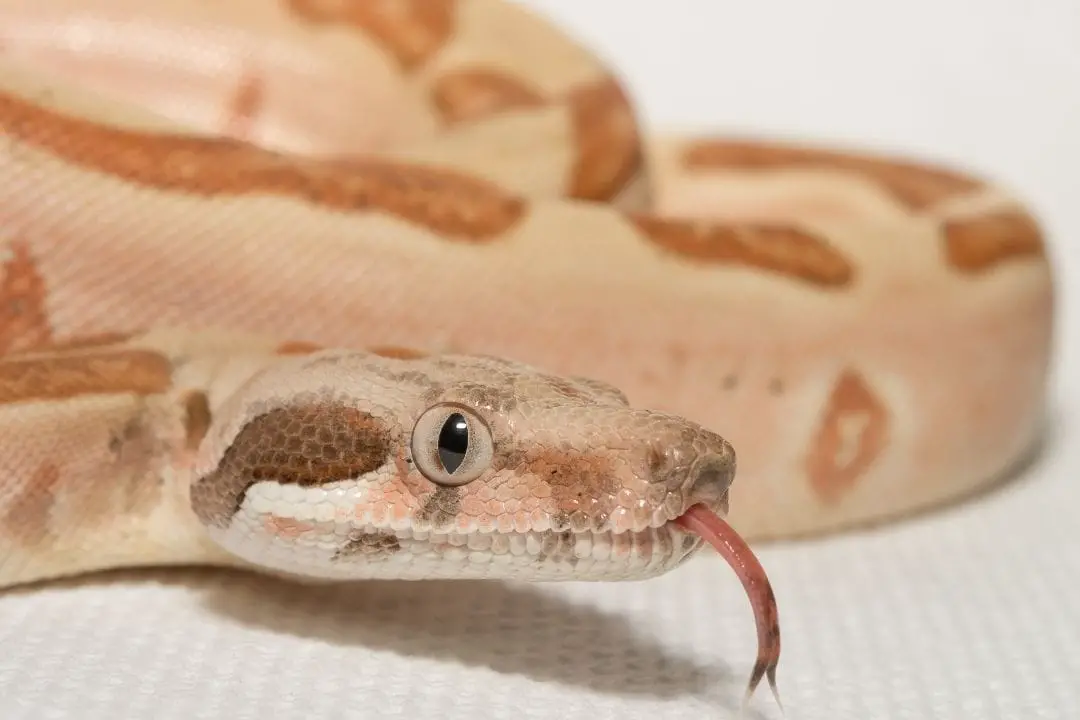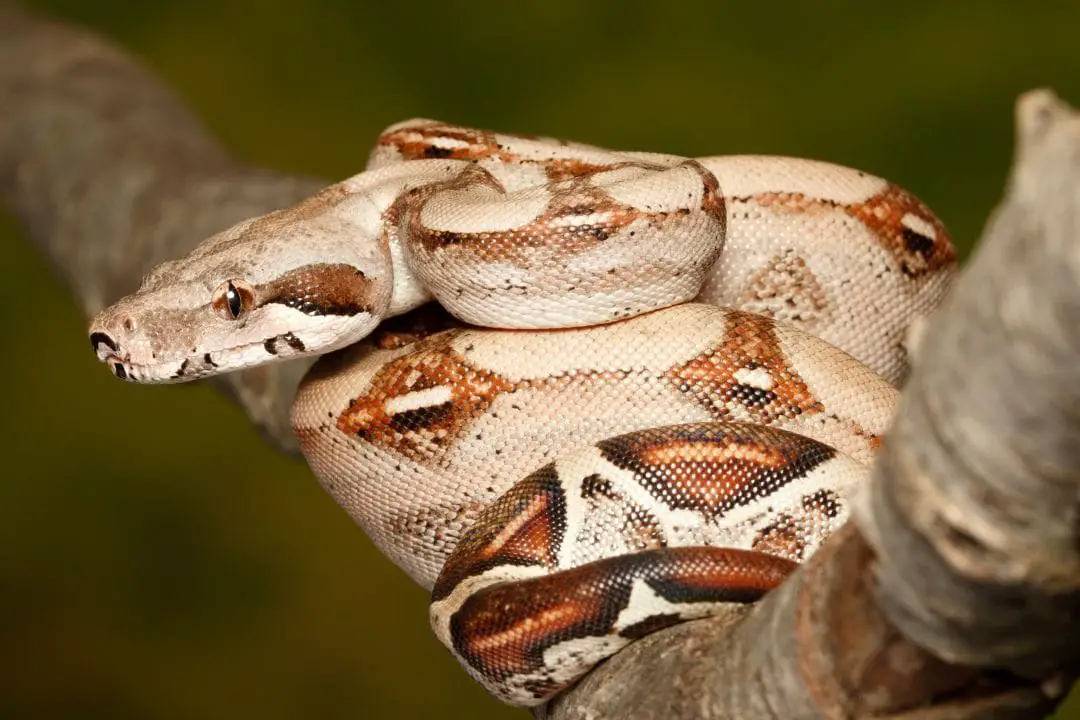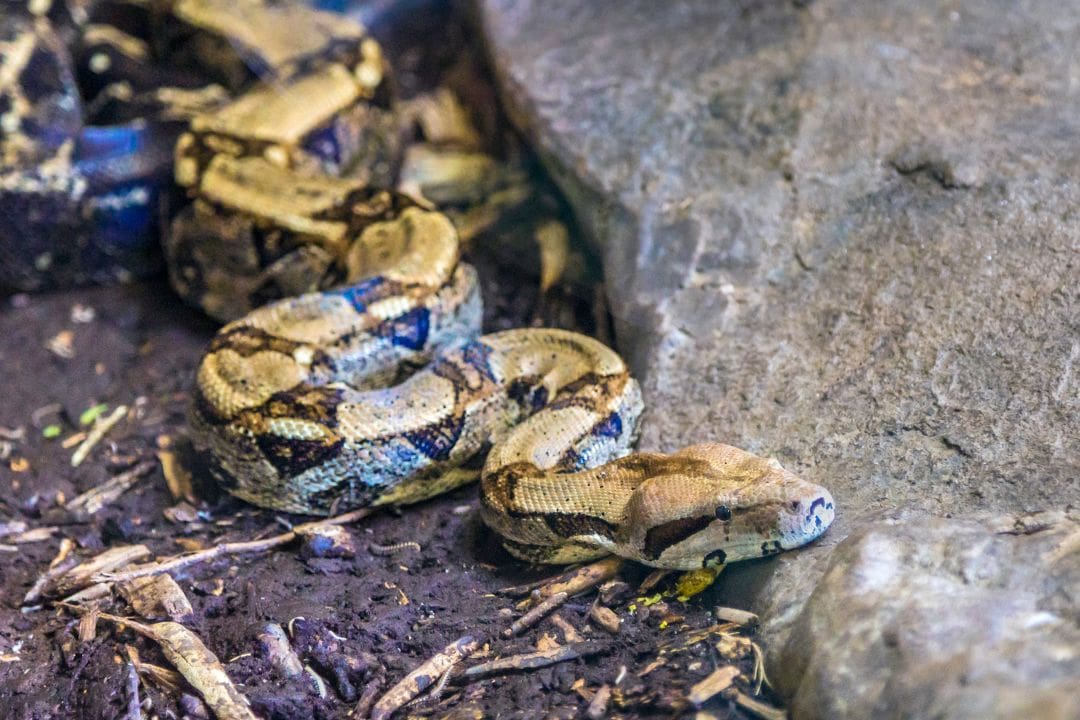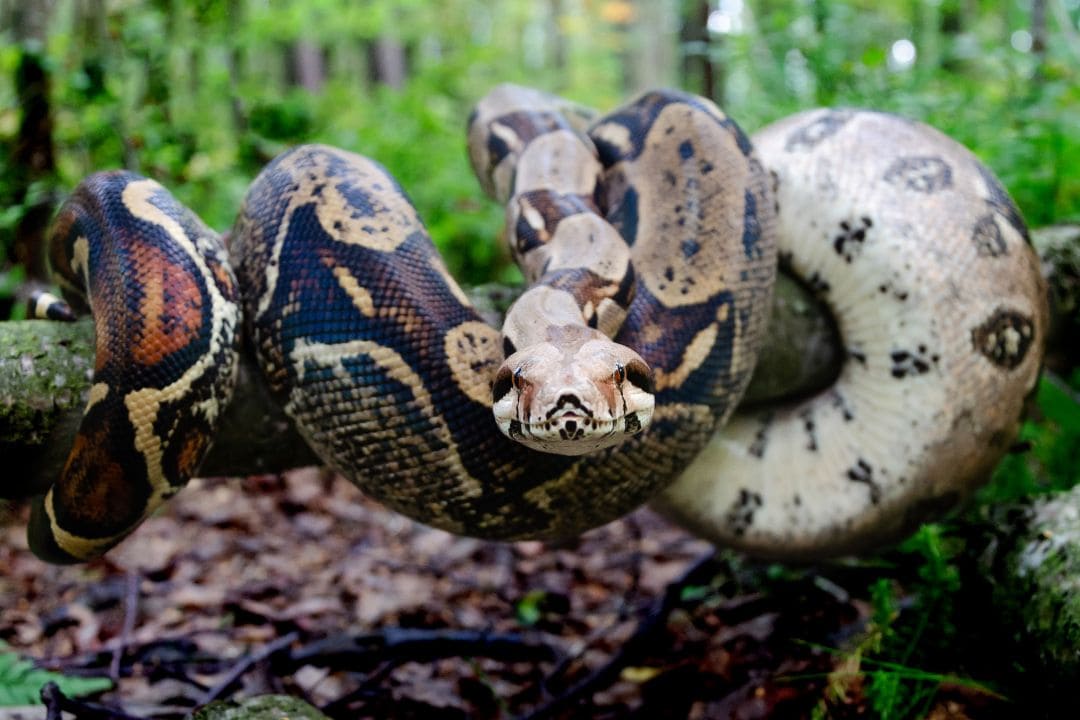Thinking about getting a baby boa constrictor? They can make great pets if you have the knowledge and ability to care for them.
This care sheet will provide you with information on properly caring for young common boas (Boa constrictor imperator).
Boa constrictor imperator is also known by other names, including the Columbian boa and the Northern boa.
It is the most widely available boa species in the pet trade, and it is found mainly in Central America and Columbia. Its habitat includes the edge of rainforests, grasslands, and woodlands.
- Housing
- Enclosure Size
- Enclosure Maintenance
- Feeding your Snakelet
- First Shedding
- Common Issues
- Frequently Asked Questions
- How much is a baby boa constrictor?
- What will a baby boa constrictor look like as an adult?
- Where can I get a baby boa constrictor?
- What should I feed a baby boa constrictor?
- How do I sex a baby boa constrictor?
- Are baby boa constrictors good pets?
- How big is a seven-month baby boa constrictor?
- What are baby boa constrictors called?
- Sources
- Conclusion
Housing
This section will cover what you need to know about setting up housing for your baby boa. Also, it is recommended that you only keep one snake per enclosure.
Boas are solitary animals, and keeping more than one animal together can pose husbandry issues.
Juvenile Boa Enclosure
Providing the proper enclosure for your baby boa requires more planning than it does for an adult boa.
There are two main reasons for this, with the first reason being that you have a boa!
Boas can attain a length of eight feet. Further, baby boas can triple their length in the first year.
So, the first question that you need to ask yourself is should the enclosure be oversized to accommodate your baby boa’s growth.
The second reason you want to plan carefully is that providing an oversized enclosure for your baby boa does come with some disadvantages.
The following are the points that you need to consider when placing a baby boa in an oversized enclosure:
- Stress: Baby boas spend much of the time hiding. Their small size makes them an easy meal for a predator in the wild. Placing a baby boa in an oversized enclosure will make it feel exposed unless you provide ample opportunities to hide.
- Hide & Seek: A hatchling boa in an oversized enclosure can make it more difficult for you to locate it.
- Monitoring: An oversized enclosure can make monitoring your baby boa’s defecation frequency more difficult.
- Drowning: Deepwater dishes can pose a drowning hazard for your hatchling snake.
Enclosure Size
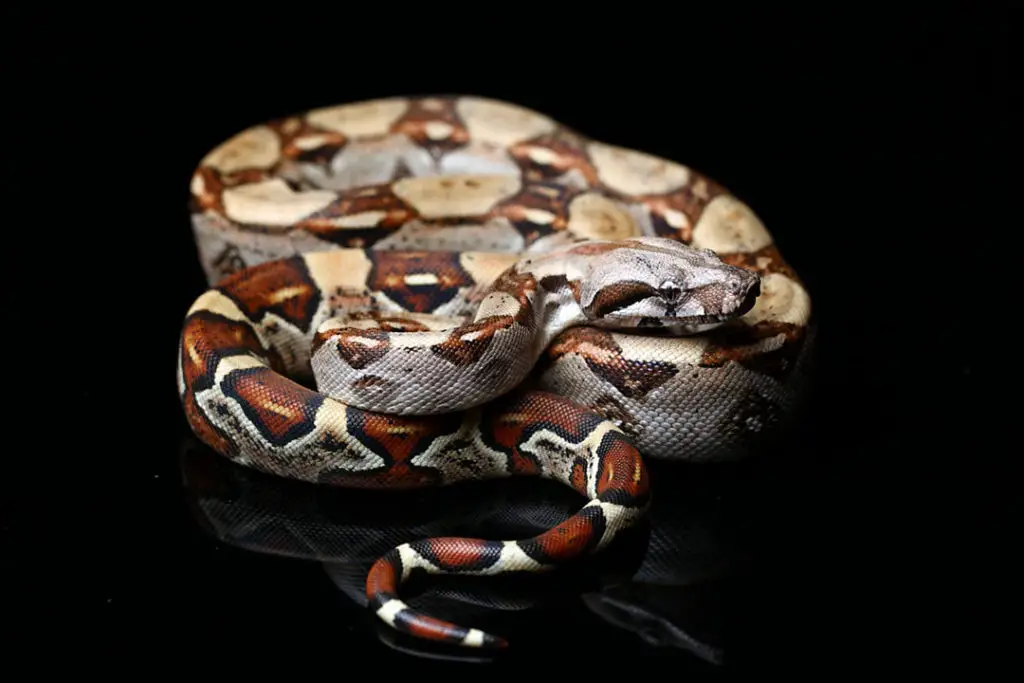
If you decide that you will deal with your baby boa’s growth at another time, providing suitable housing is quite simple.
Recommended Enclosure Size for Baby Boa Constrictors
Boas are considered to be babies till they reach two feet in length.
At this age, an enclosure of 2’L x 1.5’W x1’H should be the minimum size for your snake. The enclosure should be large enough for it to stretch out fully.
For juveniles (between two and five feet in length), the enclosure should be a minimum of 4’L x 2’W x 2’H.
The minimum size enclosure for an adult snake (between six and eight feet in length) is 6’L x 3’W x 3’H a big female boa might need even more.
Commercial Terrariums
Premade enclosures are widely available, and they are ideal for baby boas.
Custom Reptile Habitats – PVC & Aluminum Enclosure – 48 L x 24 W x 24 H
- Sliding glass doors – Enjoy this big viewing area with crystal clear 1/4 inch Tempered glass that won’t scratch or discolor over time
- Stunning design with super strong Anodized Aluminum frame – Looks great in your home and will never rust or peel
- Real PVC panels – The preferred choice for reptile enclosures. Holds high humidity and will never break, rot or catch fire
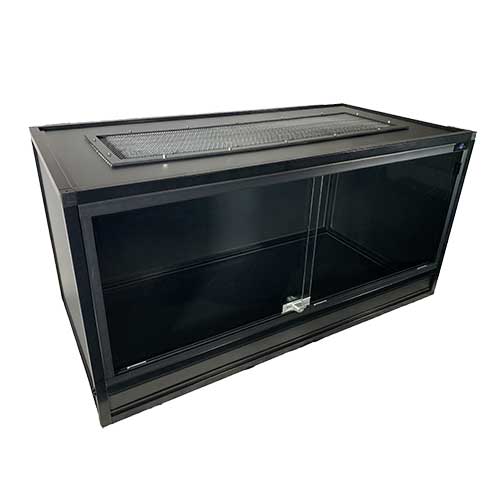
If your budget allows it, I highly recommend Custom reptile habitats. Other examples include Zoo Med Double Door Naturalistic Terrarium, and Boamaster PVC Reptile Cage.
Your baby boa can also be housed in a 10-gallon aquarium, though a 20-gallon aquarium would be even better as it will not take long for them to outgrow the 10-gallon.
Beware though, newborn and younger boas tend to be escape artists and glass aquariums are not meant to secure reptiles in.
DIY
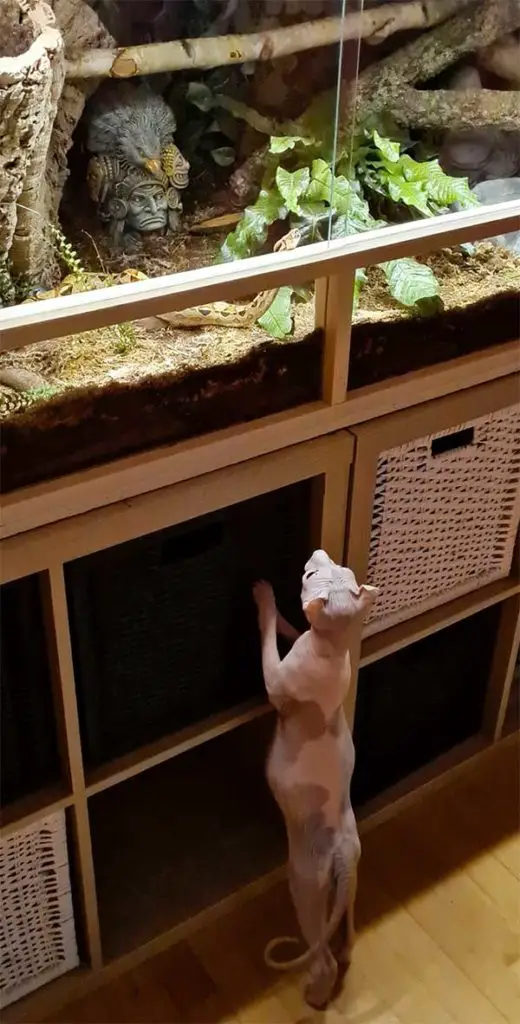
You may want to consider making your own enclosure if you want a large enclosure for your baby boa. Large premade enclosures are difficult to find, and they are expensive.
When making your custom enclosure, it is important to consider the material that you are using:
- Glass: The advantage of using glass is that it dissipates heat. Because of this, it will be easier for you to create a temperature gradient (see temperature section). Also, glass is easy to keep clean. If you make a glass enclosure, it is recommended that you cover three of the four walls with an opaque material to make your snake feel more secure.
- PVC/Plastic: PVC is commonly used in building reptile enclosures because it is durable and holds heat and humidity.
- Wood: Wood has the advantage of being inexpensive and lightweight. The disadvantage of using wood is that it can rot and harbor mold. For this reason, it is recommended that you treat the wood with a safe waterproofing agent. You want to avoid agents that contain VOC.
For getting helpful information on building the enclosure, check out the FaceBook group, DIY Reptile & Amphibian Enclosures.
Get or build a front opening enclosure
Whether you are making your enclosure or purchasing one, it is recommended that you get one that has a front opening instead of a top opening.
A front opening enclosure will make your snake feel safer. In the wild, most predators of baby snakes strike from above.
Also, the front opening makes enclosure maintenance easier. Also, snakes are escape artists. Ensure all openings are secure and cannot be dislodged by the snake.
Substrate for Baby Boas
The substrate is an important part of your pet boa constrictor enclosure because it will help maintain the humidity level, make cleaning the enclosure easier, and make it more attractive.
Further, the substrate provides a comfortable surface for your snake, and it can use to burrow in.
ReptiChip Compressed Coconut Chip Substrate
- This encapsulates waste product, creating a healthy environment for your pet and ensuring your own home is pleasant-smelling.Easy to hang and create an arboreal shelter
- Great humidity retention makes it easy to reach and maintain the required humidity levels
- Coco chips are highly sustainable and earth-friendly.
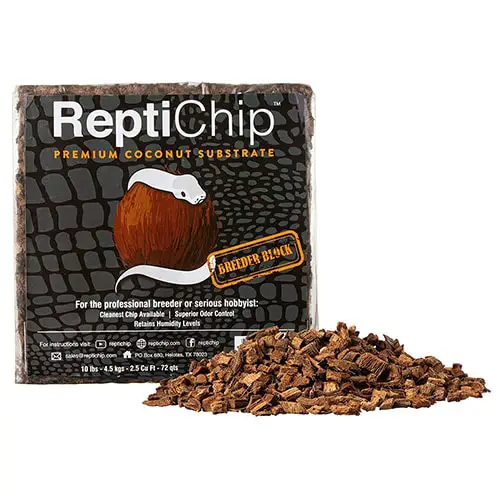
Recommended substrate includes orchid bark, coconut chip, aspen shavings, and cypress mulch. Commercial brands are widely available, some of which include Zilla Jungle Mix, Zoo Med Repti Bark, and Zoo Med Aspen.
On the low end, you can also use newspaper, but it will not help maintain the humidity.
Heating
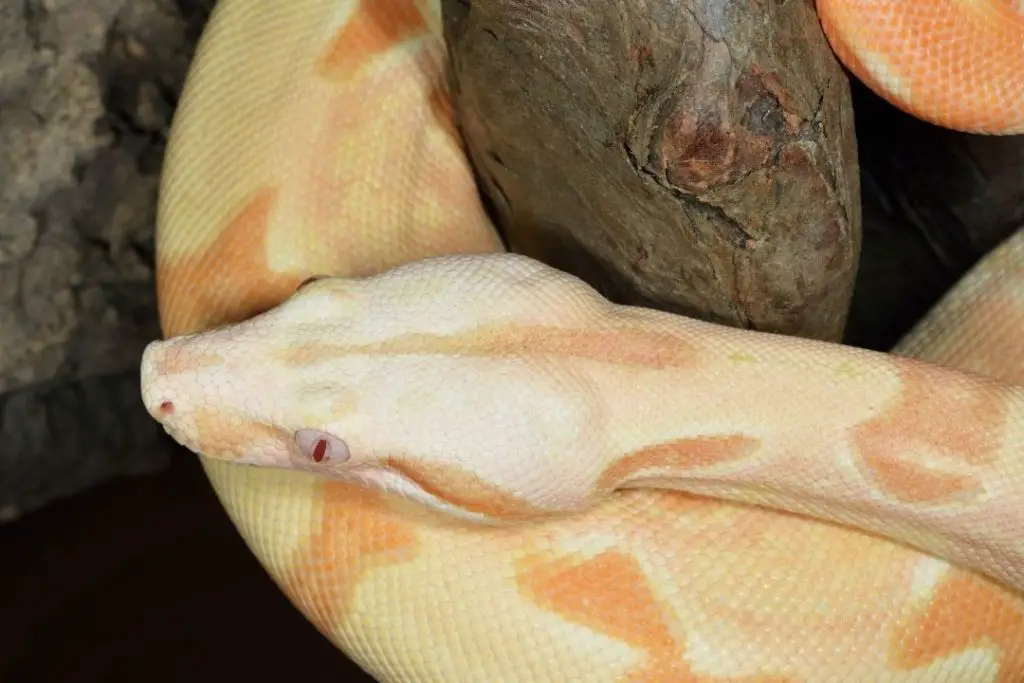
As with other reptiles, boas are exothermic. As mammals, we generate our own heat internally. Also, we can cool ourselves by sweating.
Exothermic animals are unable to regulate their temperature internally. Instead, they need to find places in their environment that meet their temperature needs.
Because of this, you must create a temperature gradient within the enclosure.
A temperature gradient is a fancy name for setting up the enclosure so that one end is cooler than the other.
Temperature Gradient for Juvenile Boas
The warm end of the enclosure should be between 88-90 degrees Fahrenheit, while the cooler end should be from 80-85 Fahrenheit.
Nighttime temperatures should be around 78 degrees Fahrenheit. Purchase two accurate thermometers and place one on each end of the enclosure so that you can monitor the temperature.
You can also purchase a thermostat to maintain the temperature.
You can purchase an under-tank heating pad, heat lamp, or a ceramic heat emitter to heat the enclosure. Brand names for under-tank heating pads include Zoo Med Heat Mat and Exo Terra Heat Pad.
When using a heating pad, position it to only covers half of the enclosure.
A ceramic heat emitter can be placed outside the enclosure (if you have a screen top), as can the heat lamp. Whichever method you use, ensure that your snake cannot come in direct contact with it.
Your snake may seek out the heat and burn itself. For this reason, you should never use heating rocks inside the enclosure. Protective light domes will keep your snake from coming in contact with heat bulbs. Brand names include Exo Terra and Flukers.
Note: If your enclosure is made of all glass, ensure that there is ventilation around the heat source. Without ventilation, the enclosure may become damaged.
Is UVB Lighting necessary?
The lighting requirements for your boa are simple to meet. The common boa does not require any special lighting. As this species is largely nocturnal, UVB is not necessary.
Some reptile keepers use UVB on their common boas, but there is no documented evidence that it is needed. You can use overhead lighting to illuminate the enclosure or rely on the natural sunlight that enters the room.
If you use overhead lighting, use a low-wattage fluorescent bulb. You can equip the enclosure with a timer so that your snake can experience the day-night cycle.
Shelter & Branches
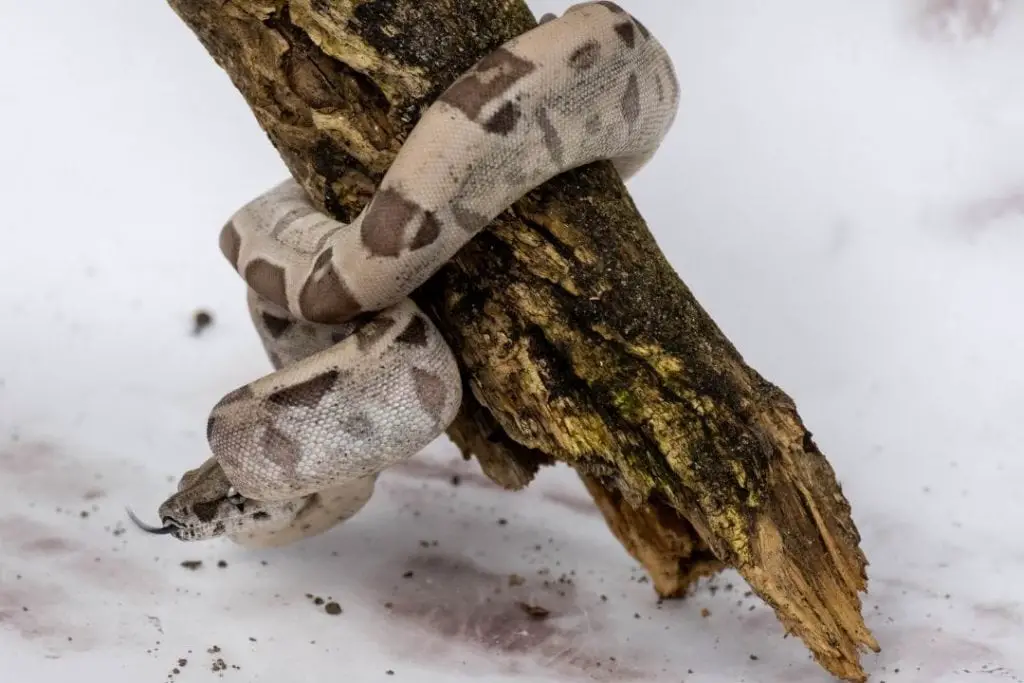
In an earlier section, it was mentioned that if you plan to keep a baby boa in an oversized enclosure, it is important that you set it up correctly.
To set it up correctly, you need plenty of hiding places for your baby snake. If the substrate you use is loose enough, it may burrow beneath it.
Besides substrate, it is recommended that you add cork bark that is partially buried in the substrate, caves, and reptile hides, such as the Zilla Habba Hut:
Zoo Med Habba Hut Natural Shelter, Giant
- Real wood
- All natural den
- Proper shelters reduce stress
- This is a natural alternative to plastic or resin hiding area
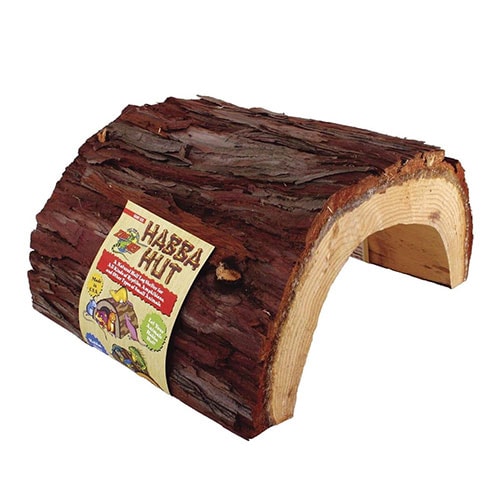
Regardless of the age of your boa, it is necessary to provide them with at least two hides. As with many snakes, boas prefer to spend their time in dark and secluded places.
Hides give your snake a sense of security. When choosing hides, you want ones that are just big enough to contact the snake when it is in the coiled position.
Being able to feel the walls of the hide makes snakes feel safe. You should position hides on each end of the temperature gradient, so have one at the heated end and one where it is cooler.
Young common boas will climb, so you can add a few branches for them to climb on. As the snake gets older though, an adult boa constrictor will climb less frequently.
Do not use branches or other plant material from the outside without first treating them as these can carry parasites. Instead, you can get branches and cork bark from a pet store or an online reptile store.
You can create arboreal hides for your boa by partially covering the branches.
Water
Make sure that your boa has water at all times.
Use a shallow water dish for baby boas to avoid potential drowning hazards. As your snake gets larger, you can provide deeper water dishes.
The water should be changed daily, and the water dish should be scrubbed and cleaned weekly.
Humidity levels for Newborn & Juvenile Boas
Proper Humidity Percentages to Maintain
The humidity level should be between 60 and 70 percent. When it comes to humidity, you want the enclosure to be humid but not damp.
A damp enclosure can lead to mold, scale rot, and respiratory disease. Purchase a hygrometer so that you can monitor the humidity level. Ways to increase the humidity include misting, substrate, and water dishes.
There are three main ways to maintain the proper humidity:
- Misting: Use a spray bottle to mist the enclosure daily. There are also automated misters that are available on the market, such as Exo Terra Monsoon or Zoo Med Fogger. If your enclosure has a screen top, you can partially cover it to reduce moisture loss.
- Substrate: Cypress mulch and coconut fiber are excellent in maintaining moisture and can play an important role in maintaining humidity.
- Water dish: As mentioned before, provide a shallow water dish for your baby boa. Besides providing your snake with water, it will also increase the humidity level.
Enclosure Maintenance
- Daily maintenance of the enclosure should include spot cleaning the substrate by removing fecal matter, shed skin, and providing fresh water.
- Weekly, scrub and clean the water dish.
- Monthly maintenance includes a deep cleaning of the entire enclosure. Remove everything from the enclosure and use a mixture of vinegar and water to disinfect it. Also, replace the substrate.
Feeding your Snakelet
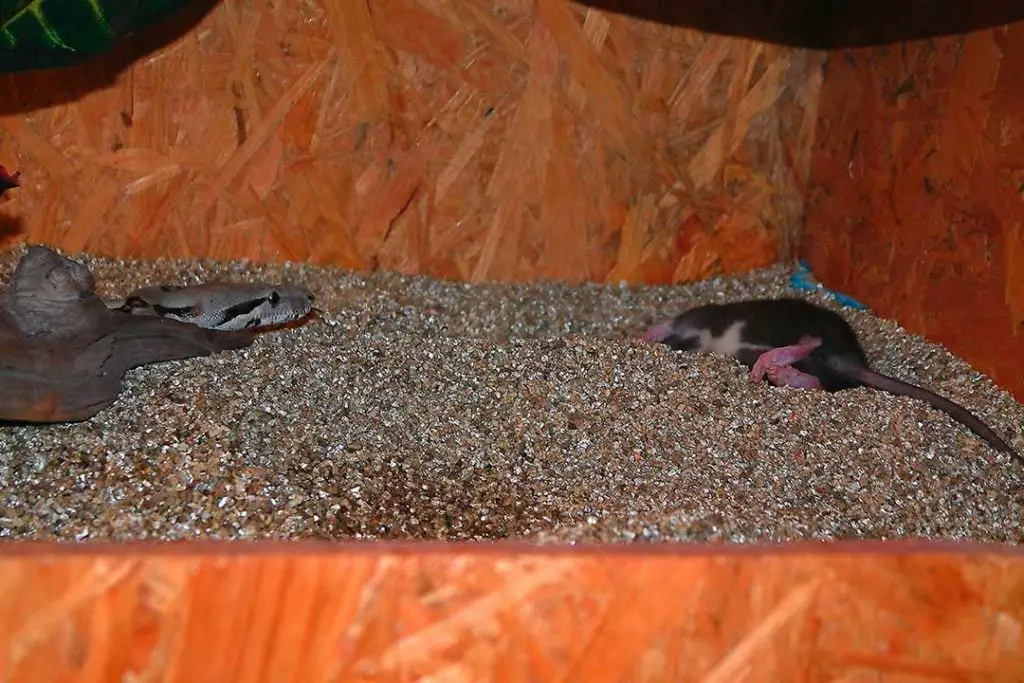
Type and Size of Prey
Baby boas can be fed fuzzy mice (also known as fuzzy rats), which are mice that are between 10-13 days old. You can purchase fuzzy mice at some pet stores or online.
It is highly recommended that you buy frozen fuzzy mice, and there are many online sites where you can purchase them if you do not have a reptile store nearby.
When your boa becomes a juvenile, you can feed it small mice.
You can determine the size of the feeders you give to your snake by selecting feeders of the same size as the widest portion of your snake. Guinea pigs and rats are common.
Getting your new snake to eat frozen
It is always recommended to feed your snake frozen feeders instead of giving them live prey. The main reasons why feeding frozen feeders are preferred are:
- Avoid risking injury to your snake. It is not uncommon for live mice and rats to injure or even kill snakes.
- Frozen feeders are free of parasites.
- You can store frozen feeders in bulk, which will save you money.
When feeding frozen feeders, it is important to warm them up before you offer them to your snake. You can place the frozen feeder in a zip-lock plastic bag and submerge it in warm water.
Some keepers warm their feeders to up to 100 degrees Fahrenheit, which is the body temperature of a live mouse.
Use feeding tweezers or tongs to present the frozen feeder to your snake. By wiggling the feeder, it will mimic the movements of live prey.
How Often to Feed
Boa constrictors tend to be voracious eaters. It is not uncommon for pet boas to be overfed, which leads to obesity.
Offer baby and juvenile boas one frozen feeder every seven days. When your snake reaches 1-2 years of age, you can feed them every 7-14 days.
First Shedding
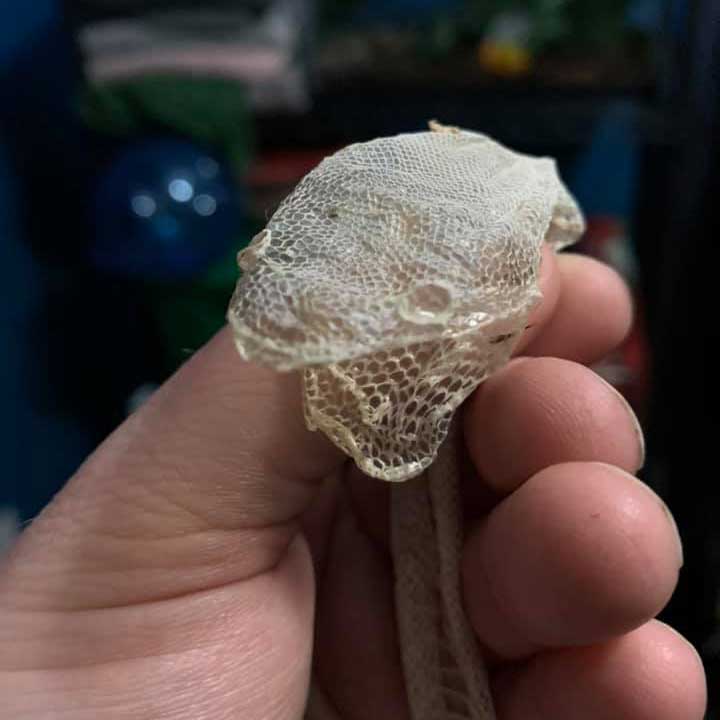
As they grow, snakes shed their skin. The older the snake becomes, the less often it will shed. Baby and juvenile boas may shed every two weeks.
Before shedding, young boas will often soak in their water dish.
There are three stages to the shedding process:
- Pre-shed: At this stage, your snake’s color will appear duller and darker than normal. Also, it may develop a pinkish tint on its belly. Additionally, your snake may stop eating.
- Blue Phase: Your snake’s eyes will appear clouded or milky during this stage. This discoloration of the eyes makes it difficult for snakes to see. For this reason, they will become more defensive and irritable. You should avoid handling your snake during these times.
- Clearing: Your snake’s eyes will clear up at this stage, and it will look normal again in its appearance. This return to normal is caused by the fluid between the old and new skin drying up.
When your snake passes the clearing stage, it will be ready to shed its old skin. Your boa will rub its nose against the sides of the enclosure, the substrate, or other objects.
When the snake breaks open its old skin, it will crawl out of it. When your boa has shed its skin, remove it from the enclosure and check that the shed includes the eye caps and tip of the tail.
If your snake does not undergo a complete shed, let it soak in warm water. You can then try to peel off any remains of the old skin.
Such occurrences do not necessarily mean there is a husbandry issue. However, if your snake has trouble shedding or it sheds in patches, it is a sign that the humidity level of the enclosure is not high enough.
Pet snakes should resume feeding soon after they shed.
Handling and Behavior

Having a successful handling experience begins will developing trust with your snake. For the first week, do not attempt to handle your boa unless it is necessary.
Allow it to get familiar with its new home. After a week, you can start initiating contact with your snake. Start slowly by handling it for only a few minutes. Do this once a day for two weeks.
Baby Boas are usually more defensive and reactive than adults
Keep in mind that juvenile boa constrictors tend to be a lot more defensive and nippy than adult ones. Some of them will naturally be very tame, but most baby boas will hiss and strike.
They are a lot more vulnerable as babies in the wild, which explains why they are a lot more defensive when young. Keep at it and don’t be afraid to get bitten!
Avoid approaching the snake from above, and don’t do any sudden movement. Keep calm and your baby snake will get used to handling.
When picking up your snake, move slowly and never grab your snake. Instead, gently lift it from underneath. While holding your snake, do not try to restrain your snake. Instead, let it move about freely.
Use your hands to control the direction of its movements.
Also, they are head shy, never touch your snake’s head until it feels comfortable with you.
After the second week of gentle handling, you can gradually increase the length of the handling sessions. Some people will recommend using a snake hook, I don’t think it’s necessary for this species.
Do not handle your snake when it is getting ready to shed or for two hours after eating.
Common Issues
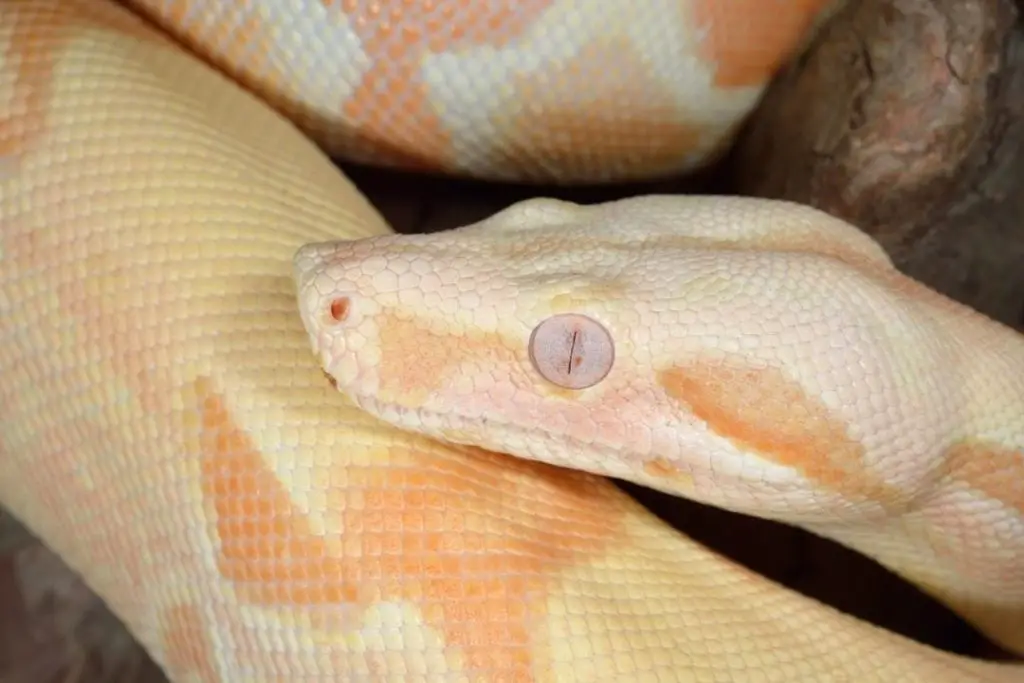
My Snake Is Not Eating
Boas are normally good eaters in captivity. Common reasons for refusing to eat and a lack of feeding response include:
- Your snake is getting ready to shed.
- Your snake is going through brumation, which occurs when a reptile’s metabolism slows down because of seasonal weather.
- The enclosure is not at the correct temperature.
- Your boa is stressed.
- The frozen feeders you are giving to your snake are not warm enough.
Regurgitating
Regurgitation is usually caused by handling your snake too soon after eating, or the enclosure’s temperature is not high enough.
Respiratory Infections
Respiratory infections are caused by improper husbandry methods, including insufficient temperature gradients or improper humidity levels. Symptoms of respiratory infection include:
- The snake keeps its mouth open.
- The snake wheezes while breathing.
- There is nasal discharge or discharge from the mouth. Do not wait to get your snake to a veterinarian if you see this.
- Labored breathing.
- Refusal to eat.
If you suspect your snake has a respiratory infection, make the needed adjustments to the temperature or humidity. If the snake shows no improvement, bring it to a veterinarian familiar with treating reptiles.
Frequently Asked Questions
Sources
Hill, R.L., Huskisson, S.M., Weigel, E. and Mendelson III, J.R., 2019. Growth rates of juvenile Boa constrictor under two feeding regimes. Zoo biology, 38(2), pp.209-213.
STONE, A. and HOLTZMAN, D.A., 1996. Feeding responses in young boa constrictors are mediated by the vomeronasal system. Animal behaviour, 52(5), pp.949-955.
Conclusion
We hope that you enjoyed this care guide on baby boas these are a very popular species amongst reptile enthusiasts and for good reason.
Also read my article for adults, the boa constrictor general care sheet. If you have any questions or comments, please let us know.
